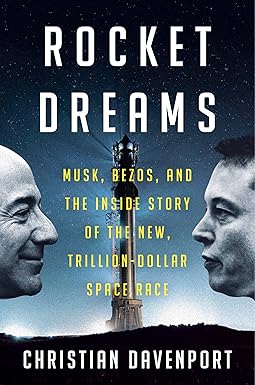Centauri Dreams
Imagining and Planning Interstellar Exploration
A Spacecraft in Your Pocket
Last week we looked at Mason Peck’s ideas on ‘Sprites,’ tiny spacecraft the size of computer chips that could be sent in swarms to targets near and far. I was particularly interested in Peck’s idea of using Jupiter as a massive particle accelerator, bringing huge numbers of Sprites up to speeds in the range of hundreds of kilometers per second. Growing out of Clifford Singer’s insights in the 1970s and given onboard intelligence by Gerald Nordley, the idea of ‘smart pellets’ thus moves beyond a propulsion method to become a fleet of networked space probes.
Perhaps one day we’ll be able to use the tools of nanotechnology to create highly intelligent vehicles of extremely small size, rendering the propulsion problem a bit more tractable. But until we’re at that level, it’s fascinating to see the groundwork being laid in work like Peck’s. Today I want to talk about another experiment with space vehicles that are smaller than a compact disc and as thin as a piece of paper. Pocket Spacecraft are being developed for launch in a CubeSat for a range of potential missions in an energetic attempt at space crowdsourcing.
We’ve already seen crowdsourcing at work in projects like KickSat, which is still in the works in the capable hands of Zachary Manchester at Cornell despite an initial setback last April. KickSat would have deployed a large number of Sprites for early testing, as will, presumably, the follow-up KickSat-2. Some members of the KickSat team have also gone on to work on Pocket Spacecraft, a project that has tapped the skills of volunteers from over twenty countries, and one that has played a major role in conferences like the Interplanetary CubeSat Workshop (MIT) and a Caltech event called Small Satellites: A Revolution in Space Science.
So what are Pocket Spacecraft? The image below gives you the gist of a spacecraft small enough to fit in your pocket, essentially a disk made out of the same material you find in flexible circuit boards. The polyimide disk is ringed by a nickel titanium hoop that contains memory and doubles as an antenna for the diminutive vehicle. Let me quote from the Pocket Spacecraft site to continue the description:
Solar cells, a thinned commercial off the shelf system-on-a-chip die (ground down with diamond sand paper) and support components, sensors and instruments are bonded or printed on the polyimide and protected with a conformal coating resulting in a spacecraft with an average thickness less than one twentieth of a millimetre (two thousandths of an inch), and a mass much less than a gram (a thirtieth of an ounce).
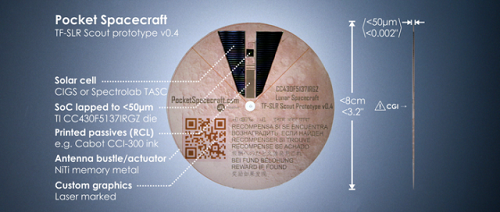
Image: Thin-Film Scout prototype consisting of a polyimide substrate, bonded solar cells and thinned die, printed passive components, antennas and images. Credit: Pocket Spacecraft.
The upshot is that Pocket Spacecraft can be packed tightly, thousands to a single CubeSat ‘mothership.’ We’ve seen that CubeSats are destined to be true workhorses for inexpensive space missions, a fact underlined by recent NASA studies on CubeSats in interplanetary space. In February of 2013, NASA selected 24 small satellites to fly as auxiliary payloads on rockets planned for launch in the next two years, the CubeSats being proposed coming not only from NASA centers (three from JPL) but educational institutions and non-profit organizations.
We’ve also seen that The Planetary Society has been engaged in a lengthy study of solar sails, with plans for its LightSail-1 to be deployed from a CubeSat. Potentially, the tools are all here to allow us to fly CubeSats with different instrument configurations to a wide range of targets in the Solar System using solar sails for propulsion. The Pocket Spacecraft team also speaks about another option, a system based on electrolysis, using solar power to break down liquid fuel. Its CubeSats are radiation hardened and contain the subsystems needed to communicate with Earth as well as to release and photograph the numerous CD-sized Pocket Spacecraft.
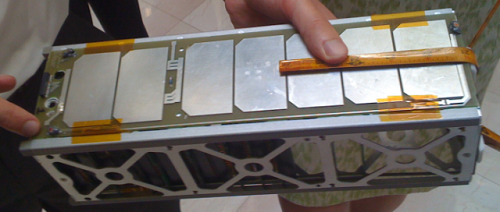
Image: An engineering model of a 3U CubeSat, the largest most commonly launched CubeSat format. Credit: Pocket Spacecraft.
Call them ‘Scouts,’ as the Pocket Spacecraft team does. The Scouts house integrated optical and radio transceivers and sensors including an accelerometer, gyroscope, temperature sensor, and single pixel optical sensor. Using online tools including smartphone apps, contributors to the project can take a role in personalizing an individual Scout and, using a Web browser, can participate in science experiments. The more technically inclined can use Arduino tools to run their own software on Scouts, backed by a Web-based integrated development environment.
So the crowdsourced side of this project is engaging because it’s not just a matter of contributing money, but of participating in an active way with a space mission. Some Scouts are to be released from Earth orbit to test their ability to re-enter the atmosphere, taken measurements of the Earth’s thermosphere along the way. Others will be flown on a low energy transfer orbit to the Moon for release and landing on the surface. The attempt is to show that a collaboration of private citizens operating on a shoestring budget can design and build spacecraft that can travel not just into orbit but to the Moon and theoretically further given the new generation of sail-enabled CubeSats now beginning to come online.
The issue I’d be most concerned with in this scenario is communications. Telemetry is to be transmitted either directly from the Scout spacecraft to Earth or through the CubeSat mothership, depending on the distance of the Scout. Pocket Spacecraft says it will take care of the communications infrastructure, which could involve amateur radio equipment at one end and, as Scouts get closer to the Moon, repurposed radio telescopes. Assuming this works, the telemetry is to be made available through a smartphone app as well as public servers.

Image: Lapping (thinning) a pocket spacecraft chip die using diamond ‘sandpaper’ (left) and testing the final part (right). Credit: Pocket Spacecraft.
The theme of miniaturization is the obvious driver for this entire project. From the site:
Even though our spacecraft are small, they are mighty. If you look beneath the superficial cosmetic customization of the surface of the spacecraft, you will find computing power comparable to that of the Voyager spacecraft and Apollo flight computers. Thanks to the spectacular advances in semiconductor technology and the widespread low cost availability of what once would have been considered high precision scientific instruments that are now commonly found in cell phones such as accelerometers and magnetometers, we are building tiny high performance inexpensive scientific spacecraft accessible to all.
I’m glad to see that the Pocket Spacecraft team has software development options for Scouts that allow schools or clubs to support up to 50 users for customizing onboard systems. A software Scout simulator and virtual Solar System are being established to test out customization ideas along with swarm communications possibilities. So the intent is to let users be ‘hands-on’ throughout the process from Scout building and lab testing to space operations.
We’ve talked about a future where long-haul ‘swarm’ spacecraft are a possibility, but one that demands huge advances in nanotechnology, artificial intelligence, networking and communications. We get to a future like that by making experiments one step at a time to discover the issues that need to be addressed. We move incrementally forward. Pocket Spacecraft, using off-the-shelf equipment and private money, should engage the interest of the public and, if successful, provide useful data applicable to future feats of miniaturization. Click here for further information.

First Words: Remembering July 20, 1969
I had hoped that the anniversary of the Apollo 11 landing would stir up some memories for Centauri Dreams regular Al Jackson, and I was not to be disappointed. Here, spurred partly by weekend news reports questioning who said the first words from the Moon, Al thinks back to a time of Champagne and jubilation, and gives us an inside look at those famous first words. He was also kind enough to pass along some of his own photos. A widely known figure in the interstellar community, Al was astronaut trainer on the Lunar Module Simulator and worked closely with, among many others, Neil Armstrong and Buzz Aldrin. He is also a man who never forgets a single thing he has ever read, as I learn every time I talk to him about science fiction, which I hope to do again this fall in Houston.
by A. A. Jackson

The 45th anniversary of the Apollo 11 landing was on a Sunday, just as it was on July 20 1969. My wife (of one year) and I lived in the Dijon Apartments in Clear Lake City, Houston. So for most employees this was not a work day at the Manned Spacecraft Center…of course quite a few people were in Building 30, not only Mission Control but also in the back-up rooms that surrounded it. Every flight controller was in contact with at least two specialists who were sitting at consoles across the hall, for instance MIT people who created the software for the CM and LM primary guidance and control system (the GN&C computer, as known then, and the PNGS, pronounced ‘pings’).
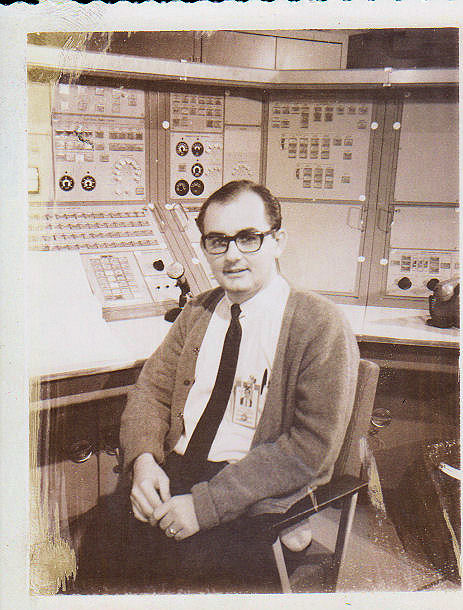
Image: A Polaroid shot CBS took of Al Jackson in the 1960s, during filming for Walter Cronkite’s Twentieth Century TV program.
I put a bottle of Champagne in our fridge freezer that morning, took it out around 11 AM and the damn thing had frozen! Good thing it did not explode! Put that in my briefcase, told my wife I was going on-site to listen to the landing. I did that because as an Apollo instructor I knew that the Lunar Module Simulator consoles had the Flight Director’s loop, which was not fed to the TV networks. When I got to building 5, where the simulators were, some of my colleagues said it sure would be good to have a TV, even though there was air to ground video. We knew of only one, it was in Division chief Warren North’s office in Building 5, the next building over from where our offices were. So we went over there — Warren was there, but quickly invited us in.

Image: Al Jackson helping to run a 1968 test of the environmental control system on the LM simulator, with the cockpit of the LM behind him.
Turned out, we may have known this, he had the Flight Director’s loop up on a speaker in his office. So we watched the TV and listened to Gene Kranz’s loop. The nice thing about that was Kranz had not only Cap Com but all the flight controller’s loops open and the ‘air to ground,’ so everything. Listened to the landing,* this was about 2:18 CT that Sunday. I told one of my friends I had a bottle of Champagne and was going for some paper cups. Even in those days we were not supposed to have alcohol in an undesignated federal facility, he didn’t know how a division chief might respond! So after about another hour, knowing that the EVA would not be until 9 pm, we all went home. I put the bottle in the fridge. Later my wife and I and several of my MSC friends gathered at the apartment of my closest friend and we drank that Champagne!
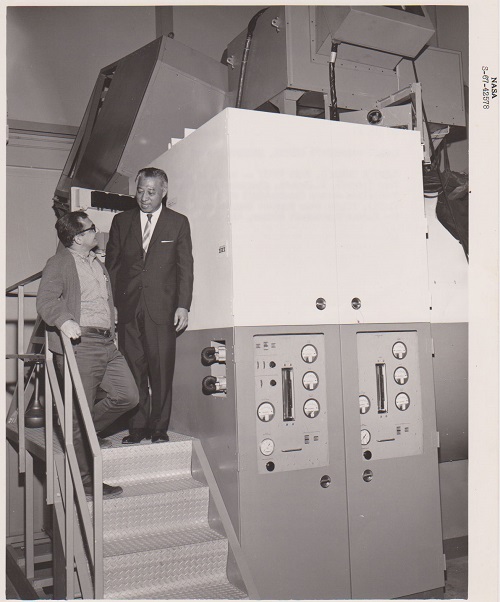
Image: Al Jackson and Senator Hiram Fong of Hawaii in 1967, in a photo taken by NASA public affairs.
Just this weekend I noticed a news article stating that the first words from the Moon were not “Houston….” They were not. I told Buzz this on the 25th anniversary and he said “Nobody cares about details like that.” The first words were technical so I don’t think many do.
I looked at several transcripts on the Web and I don’t think they are right, so I listened to the air-to-ground again and here is what I hear (CC is Cap Com, CDR is commander, and LMP is Lunar Module Pilot), from 30 seconds:
04 06 45 31 CC
30 seconds.
04 06 45 32 CDR (EAGLE)
Forward drift?
04 06 45 33 LMP (EAGLE)
Yes.
04 06 45 34 LMP (EAGLE)
Okay.
04 06 45 40 LMP (EAGLE)
CONTACT LIGHT.
[04 06 42 CDR (EAGLE)
[Contact]
04 06 45 43 LMP (EAGLE)
Okay. ENGINE STOP.
04 06 45 45 LMP (EAGLE)
ACA – out of DETENT.
04 06 45 46 CDR (EAGLE)
Out of DETENT.
04 06 45 47 LMP (EAGLE)
MODE CONTROL – both AUTO. DESCENT ENGINE COMMAND OVERRIDE – OFF. ENGINE ARM – OFF.
In square brackets I put in that Neil repeats “Contact” which may have been ‘Contact Light” which the VOX cut off (this does not seem to occur in the transcripts I have read). I swear though that it is Buzz who says ENGINE STOP and ACA – out of DETENT (ACA is Attitude Controller Assembly). So really if you don’t count the landing probes touching the Lunar surface the first words from the Moon are from Buzz: “ENGINE STOP” (that does not sound like Neil to me).
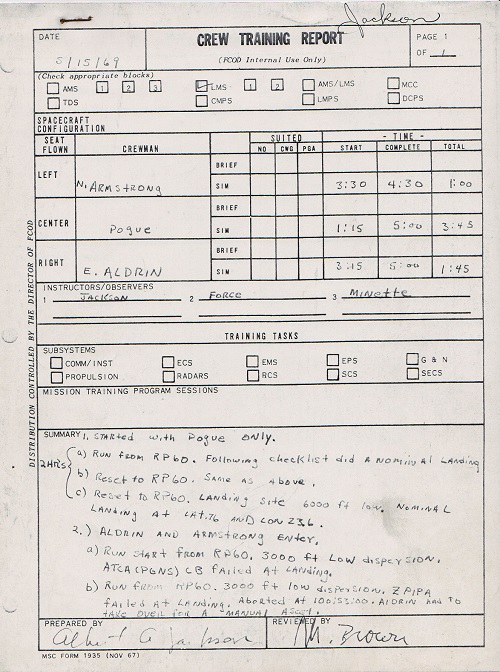
Image: The first page of an LM simulator training report, one of hundreds Al made out during this period.
* I do remember the 1201 and 1202 Master Alarms on descent. The press about that has always focused on Steve Bales, guidance officer (GUIDO), White Team, but I remember that the core to solving that problem was the back room MIT guys telling Jack Garman, group leader, program support group, Apollo Guidance Software that everything was ok, and Garman was yelling over his headset at Bales about this. Technical details no one cares about.

Neil Armstrong: ‘A Little Bit of Bedlam’
As we approach the 45th anniversary of the first landing on the Moon, journalist and author Neil McAleer has been looking back at an interview he conducted with Neil Armstrong on March 16, 1989. The author of Visionary: The Odyssey of Sir Arthur C. Clarke (Clarke Project, 2012), McAleer has lived among and written about the space community for many years. We learn little about Clarke from this interview, but Armstrong’s character comes through — he’s terse, focused, always impatient to get back to work. I suspect Centauri Dreams regular Al Jackson, who worked with Armstrong and Buzz Aldrin in his role as astronaut trainer on the Lunar Module Simulator (see The Magicians of Confidence), will recognize Armstrong’s mode here immediately. His self-imposed distance could never conceal the cool competence he displayed on the most breathtaking descent in history.
An interview conducted by Neil McAleer
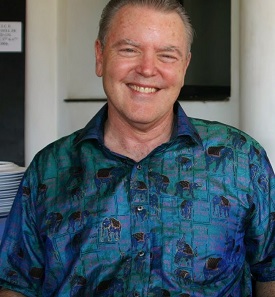
I requested this interview with Neil Armstrong 25 years ago, when I was writing and researching the first edition of my Arthur C. Clarke biography. That work was the reason. I wanted to know how they met and what kind of relationship they had during the early years of the Space Age.
The interview’s first question, not on tape, asked Mr. Armstrong if he knew how Arthur C. Clarke’s substantial Epilogue (“Beyond Apollo”) for the book First on the Moon came about.
[Armstrong] “I just don’t have that kind of information.”
This book—subtitled, “A Voyage with Neil Armstrong, Michael Collins, Edwin E. Aldrin, Jr.”–is considered the official eyewitness account of Apollo 11’s journey to the moon’s surface and return to Earth. It was published in 1970, the year after their historic mission.

[McAleer] “Did you ever actually meet Clarke, by the way?”
[Armstrong] “Yes. We attended a NASA meeting for a couple of days, and I can’t remember where it was. It seems to me it was somewhere in Virginia. [Wallops Island I found out later]. It must have been around 1970.”
[McAleer] “Did it have anything to do with the book, First on the Moon, or the afterword Clarke wrote for it?”
[Armstrong] “No, It had nothing to do with that. NASA gathered together a number of people, primarily NASA senior executives, but there were a number of non-NASA personnel also invited as well. And they were looking at the future. The purpose was to look at what the important forces and functions in the years to come might be. Arthur was an invited attendee, and I had a chance to chat. . . .”
Image: Neil Armstrong and Arthur Clarke met for the first time during a NASA conference held on Wallops Island, VA in June 1970, having shared the bus that took them out to Wallops from NASA headquarters.
A computer alarm, a harsh buzzer, sounds loudly in the background.
“Hold on!” says Armstrong, and attends to the alarm and computer challenge.
I waited about a minute and started to ask another question too soon.
“Hold on a second; I got another problem here . . . a little bit of bedlam.”
That phrase, ” a little bit of bedlam” took me back in time—I was thinking that this was an earthbound analogy to the computer program alarms that set off during the final descent of Apollo 11’s Excursion Module, the Eagle, to the moon’s surface. The first alarm sounded at about 6,000 feet above the lunar surface. And several more sounded as Eagle descended. Soon NASA made the call that the computer overload alarms were related to the rendezvous radar, and not the landing radar.
Then the second real problem: fuel supply getting extremely low and visibility poor because of kicked up dust near the surface. The fuel supply was then 20 seconds as Armstrong hunted for a smooth site without large boulders and Aldrin kept calling out Eagle’s relative position changes.
Commander Neil Armstrong and Pilot Buzz Aldrin used those seconds well and set the Eagle down–safely, without any dents, as history turned out–on the Sea of Tranquility.
A minute or two later, Armstrong was back at the phone. I gave up my flashback memories and returned to the interview—shifting from the 1970 conference to his years at Purdue University.
[McAleer] “You were in your early 20s, at Purdue, probably bogged down in engineering texts. Had you read any of Arthur’s books early on? In ’52 Clarke’s Exploration of Space was published, for example, which explored the future of space travel.”
[Armstrong] “I can’t recall. I might have started reading . . . I don’t remember things that he wrote, and that I might have read, or any impact they may have had [early in his college years]. I read many of his books subsequently, but I don’t know if they were important to me in those years.
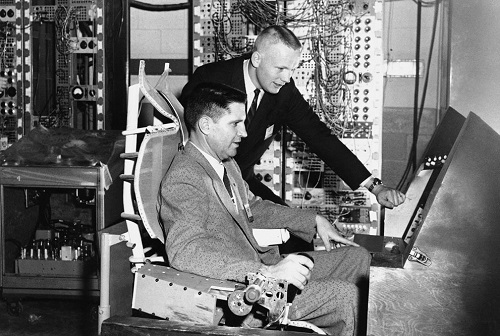
Image: NASA Tests pilots Neil Armstrong and James W. Wood (seated) working inside the simulator for the experimental Dyna-Soar spaceplane program, 1960, Edwards Air Force Base.
[McAleer] “You read the novel 2001? Before Apollo 11?”
[Armstrong] “I saw the movie. I don’t know if I read the book at that point. There were a lot of books at some point in time but I don’t know when I might have read them.”
I then told Armstrong I was looking for early influences, like Joe Allen, the astronaut, being influenced by early Clarke books. Like Carl Sagan. I refer back to his conversation with Clarke, and I say, “at the luncheon” (intending to add “of the conference,” but did not) an assumption on my part. He corrects me immediately.
[Armstrong] “Not a luncheon. It was a couple-of-day meeting, and people were giving papers and so on, and I had a chance to chat with him some at that time. And I may have met, bumped into him at other times as well; I . . . I just don’t recall.”
[McAleer] “So you don’t recall any specific conversation, even about any of the papers delivered?”
[Armstrong] “No I don’t.”
I decided—time to move on. Armstrong had a meaningful, adventurous, chock-full life, with countless specific details. Why should he be able to remember the kind of detail I was after? So I transitioned from past to present.
[McAleer] What do you think about Mike Collins’ new book, Lift Off?
[Armstrong] “It’s a good book. It’s typical Mike.” [he says, and follows with a little laugh]
[McAleer] “When is Armstrong going to tell his story? Ever?”
[Armstrong] “Well, I think the story is well documented. Since we were completely open with everything we saw, felt, heard, and ah . . . experienced at the time, there is little that can be added in retrospect that would add significantly to the history.”
[McAleer] “Even your early years? Anything out about your youth, getting a flying license, your early flying experiences?”
[Armstrong] “Ah . . . I don’t know what that has to do with Arthur Clarke.”
Armstrong’s consistency and focus wouldn’t let an interviewer–including me!–get off subject! His skepticism about some journalists, based on some bad experiences with aggressive, less-principled, and “getting it wrong” reporters, was well known.
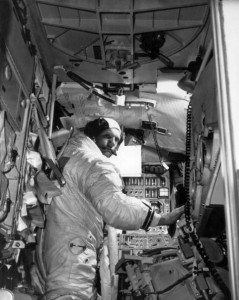
I just fell back on the truth for a defense.
[McAleer] “It doesn’t,” I confessed. “I’m making a quick transition here. I just hope someday there will be a Neil Armstrong story.”
[Armstrong] “Well, perhaps there will be something sometime.”
[McAleer] “But you don’t have any plans to move ahead with it?”
[Armstrong] “I do not.”
[McAleer] “Will you be participating in the 20th anniversary of Apollo 11 in any way?”
[Armstrong] “NASA has a number of activities scheduled that I’ll participate in.”
Image: Less than 10 years after working in the Dyna-Soar simulator, Neil Armstrong was training in the Apollo program’s Lunar Excursion Module simulator in Houston—with all the “bells and whistles.”
He paused for a second or two and then went back to the beginning of our interview. “You asked about his foreword? [for First on the Moon]
[McAleer] “Afterword,” I corrected (actually an Epilogue).
[Armstrong] “Yes, as far as I know that was not organized by the crew. That was done by Little Brown. I don’t think the crew had any discussions with Mr. Clarke about that. The crew had no participation in that.”
We had gone full circle. Armstrong had finally answered my first question precisely. Perhaps this was when the curtain comes down-—at full cycle. Yet I still wanted a few more minutes of his time. When you have the first man who stepped on the surface of the moon on the phone, you just don’t want to hang up too quickly.
I then talked to Armstrong about the idea of a 25th anniversary Apollo 11 book, and connected to that, my forthcoming meeting and interview with Ian Ballantine and his wife Betty, pioneers in paperback book publishing in the United States after WWII. Witness the year 1953: The Ballantines published many books, but among them were the first editions of Arthur C. Clarke’s Childhood’s End and Ray Bradbury’s Fahrenheit 451. That was a good year, 1953, for science fiction.
[Armstrong] “It’s not something that jumps out at me, but I remain open . . . . ”
[McAleer] So everything’s going well?”
[Armstrong] “No complaints.”
[McAleer] “Good. So any idea about when you’re going to retire?”
[Armstrong laughs] “I don’t have any idea.”
[McAleer] “The conference in 1970-—Were Mike and Buzz there?”
[Armstrong] “It didn’t have anything to do with Apollo 11. It was during the time that I was a NASA bureaucrat. I was there as part of my responsibility at NASA in Washington. I was there in an official capacity.”
[McAleer] Did you deliver a paper or anything?”
[Armstrong] “I don’t remember that I did. I just don’t recall. Clarke was the only person from what you might call the . . . [he hesitates] ‘writer’s world’. I attended a lot of these kinds of meetings. What should be going on in the future of NASA? In regards to the program planning? There were astronomers, biologists, program managers there. My responsibility was not space but aeronautics. Arthur was on the space side; that’s why he was invited.”
It was closing time; past it actually. I knew for sure.
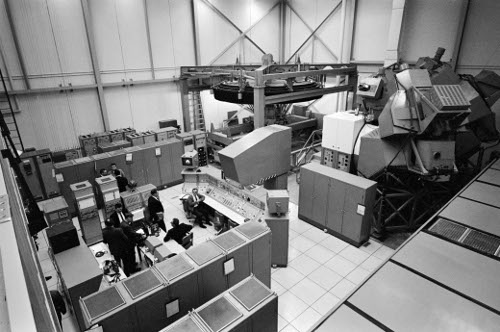
Image: Bird’s-eye view of the support components and scientists running the Apollo LEM simulator in Houston to train Apollo crew members. That’s Centauri Dreams contributor Al Jackson facing the camera at the main console.
[McAleer] “Mr. Armstrong, I’m sorry my ‘short phone call’ took a little longer than I thought.”
[Armstrong] “Well, that’s all right. I’m sorry there wasn’t anything that would be much help to you, as I said at the beginning.”
I couldn’t remember him saying that–probably because I didn’t want to hear it.
Finally I thanked him for his perspective and help, and we said goodbye.
Some interviews can often turn out to be important in an entirely different way than intended. I learned that he was still dealing with program alarms and computers in his work some 20 years after the Apollo 11 mission to the moon and back. I consider that fact amazing.
Armstrong was chairman of Computing Technologies for Aviation (CTA, Inc.) for most of the 1980s, including 1989, the year of this interview. The company was based in Charlottesville, Virginia, and it provided software for flight scheduling and support activities. This software was important to corporate jet operators to maximize the efficient use of their aircraft. And even before the Apollo 11 mission, in Armstrong’s early years of running and designing flight simulations—he had plenty of alarms as a test pilot. So computer program alarms were common events throughout much of his career—including March 16, 1989.
Actually, as my research on Clarke went forth, I did learn an important aspect of the relationship between Clarke and Armstrong. I learned that most of their primary contacts were through occasional written correspondence over the years or news from third parties. Their face-to-face meetings were very rare—possibly only that one time on Wallops Island, Virginia in 1970.
In one of the many appearances and interviews Armstrong did with Collins and Aldrin a few months later for the 20th anniversary of Apollo 11, he said this:
“We are amazed by, enthralled by, then bored by, and eventually forget some new things usually within one revolution of the Earth around the sun. That’s the way humans are. And so it’s a great surprise to me that so many people remember something that happened 20 years ago!”
Today we remember the first landing on the moon–45 years ago now. The countdown to the 50th Golden Anniversary is just 5 years away–2019.
But on March 16, 1989–25 years ago–I was fortunate and happy to speak with Neil Armstrong on that antique device, the corded telephone, about Arthur C. Clarke–and Neil Armstrong.


Sprites: A Chip-Sized Spacecraft Solution
In mid-June, NASA announced the award of two contracts with Deep Space Industries in conjunction with the agency’s plans to work with private industry in the exploration and harvesting of asteroids. One of these contracts caught my eye immediately. It involves small payloads that can ride along to supplement asteroid missions, and it’s in the hands of NASA’s former Chief Technologist, Mason Peck, a Cornell University aerospace engineer. Peck’s work at Cornell’s Space Systems Design Studio has led to the development of Sprites, fully functional spacecraft each weighing less than a penny. You can think of a Sprite as a spacecraft on a chip without any constraints from onboard fuel.

You can see where this fits in with the current theme of building smaller spacecraft and sending them in swarms to investigate a particular target. You may have already run into KickSat, a citizen science project involving hundreds of proof-of-concept spacecraft in low Earth orbit for assessment of their performance and re-entry characteristics. KickSat grew out of a KickStarter campaign from 2011. The diminutive spacecraft are 32x32x4mm in size, each weighing less than 7.5 grams, designed to be released from the larger KickSat, a CubeSat modified and enhanced for Sprite deployment, on command from the ground.
Image: Aerospace engineer Mason Peck, whose Sprite concept shrinks spacecraft to the size of micro-chips. Credit: NASA/Bill Ingalls.
KickSat was launched on April 18th of this year, the plan being to release more than 100 Sprites, which would have become the smallest satellites ever to orbit the Earth. Unfortunately, the KickSat satellite reentered the atmosphere without Sprite deployment, leading to talk of building KickSat-2. The latest KickSat-2 update from Zachary Manchester, a member of Mason Peck’s lab at Cornell, is here. But as the new satellite takes shape, let’s talk about those Sprites. For while the KickSat experiments could provide broad spatial coverage of near-Earth phenomena, there is nothing to prevent the use of sprites to create sensor nets for deep space.
Modes of Propulsion
In Exploring Space with Chip-sized Satellites, an article in IEEE Spectrum in 2011, Peck explained that radiation pressure from the Sun offers one way for Sprites to move around the Solar System. They’re too small for onboard propellant, but the ratio of surface area to volume ensures that they can be driven just like a tiny sail. Peck explains the idea in relation to a much larger sail, the Japanese IKAROS:
If a Sprite could be made thin enough, then its entire body could act as a solar sail. We calculate that at a thickness of about 20 micrometers—which is feasible with existing fabrication techniques—a 7.5-mg Sprite would have the right ratio of surface area to volume to accelerate at about 0.06 mm/s2, maybe 10 times as fast as IKAROS. That should be enough for some interplanetary missions. If Sprites could be printed on even thinner material, they could accelerate to speeds that might even take them out of the solar system and on toward distant stars.
![]()
Image: Size of the Sprite satellite. Credit: Space Systems Design Studio.
Earlier this week we looked at Jordin Kare’s work on SailBeam, a concept involving vast numbers of tiny ‘micro-sails’. The Sprite has an affinity with Kare’s thinking, but unlike Kare, who was going to drive his microsails with a multi-billion watt orbiting laser, Peck is also exploring how charged Sprites might interact with the magnetic fields that surround planets. The Lorentz force bends the trajectory of a charged particle moving through a magnetic field. Can we put a charge on a Sprite?
In his lab work at Cornell, Peck and colleagues have tested ways of exposing Sprites to xenon plasma, mimicking conditions in Earth’s ionosphere. The Sprite can use a power supply to put a potential between two wires extending from the chip, letting plasma interactions charge the device. The charge is maintained as long as the Sprite continues to power its wires, so we can turn it on and off. If we can manipulate the charge aboard a Sprite at will, then imagine exposing a stream of charged Sprites to Jupiter’s magnetic field, 20,000 times the strength of Earth’s.
Jupiter as particle accelerator? The idea seems made to order, particularly since we’ve been examining particle accelerators of a vastly different order of magnitude — remember the 105 kilometer accelerators we talked about in relation to Cliff Singer’s pellet propulsion concepts. The nice thing about Jupiter is that we don’t have to build it. Here we have a way to accelerate one Sprite or 10,000 of them to speeds of thousands of kilometers per second, at which point the chips could shed their charge and be flung off on an interstellar journey.
Peck adds that getting the Sprites up to speed might itself take decades, and the journey to the nearest star would still be a matter of several centuries. But 300 years to Alpha Centauri beats any solar-sail-plus-Sundiver-maneuver mission I’ve ever seen, and unlike the admittedly faster beamed lightsail missions (some of Forward’s missions get down to decades), the Sprites take advantage of a form of propulsion that doesn’t require vast infrastructure in space.
Near-Term Issues
We’re talking, of course, about future generation Sprites, tiny spacecraft that have been built to surmount the problems Peck’s team is now trying to solve. Take the issue of damage along the way, which we had to think about both with Cliff Singer’s pellets and Gerald Nordley’s self-steering ‘snowflake’ craft. Better build many and be prepared for some losses. Lightweight Sprites have no radiation shielding, leaving the electronics vulnerable, and micrometeorites within the Solar System pose their own threat. The way to overcome such problems in the near-term is to send Sprites in large numbers, assuming a degree of loss during the mission.
![]()
Image: Artist’s conception of a cloud of Sprite satellites over the Earth. Credit: Space Systems Design Studio.
For missions deep into the Solar System and beyond it, though, we have to solve these problems. But I love the idea of using sunlight or the Lorentz force to accelerate these tiny payloads, which also have a natural synergy with CubeSats. Remember that The Planetary Society’s LightSail-1 is testing sail deployment from CubeSats, potentially creating a way to deliver a CubeSat laden with Sprites to other planets in the Solar System. Before we think of scaling to interstellar, why not think in terms of legions of Sprites sending back data from the surface of Mars, or placed into orbits that could provide deeply detailed maps of the solar wind and flare activity?
As we do this, we can be learning how best to deploy future Sprites, and how to fabricate everything from spectrometers to load sensors and basic cameras on a chip. Peck notes in the IEEE article that almost everything a spacecraft has to do can be managed with semiconductors, from solar cells for power, capacitors for energy storage and the various requirements of memory and processing. Take these ideas down to much smaller scales and the idea of swarm probes exploring the outer planets begins to resonate, with obvious implications for the kind of payloads we will one day want to send to Alpha Centauri.

‘Smart Pellets’ and Interstellar Propulsion
When Clifford Singer proposed in his 1980 paper that a stream of pellets could be used to drive an interstellar vehicle, the idea emerged at a time when Robert Forward had already drawn attention to a different kind of beamed propulsion. Forward’s sail missions used a beamed laser from an array near the Sun, and he explored the possibility of building a Fresnel lens in the outer Solar System to keep the beam tightly collimated; i.e., we want the narrowest possible beam to put maximum energy on the sail.
It was an era when huge structures in space defined interstellar thinking. Forward’s lasers were vast and he envisioned a 560,000-ton Fresnel lens in deep space, a structure fully one-third the diameter of the Moon. Such a lens made collimating the laser beam a workable proposition, to say the least — at 4.3 light years, the distance of Alpha Centauri A and B, such a beam is still converging, and would not reach the size of its 1000 kilometer transmitting aperture until an amazing 44 light years out.
Singer’s ideas were just as big, of course, and we saw yesterday that they demanded not only a series of stations to keep the pellet beam collimated but also an accelerator in the outer Solar System that would be 105 kilometers long. If we’re building enormous structures to begin with, wouldn’t it be easier to just send laser photons than a stream of particles or pellets? The answer, and it’s surely one that occurred to Singer as he examined Forward’s ideas, is that there is an inherent downside to photon propulsion. Let Gerald Nordley explain it:
The pellet, or particle, beam propulsion system is conceptually similar to photon beam propulsion systems discussed by Forward and others. While the concept is feasible, the reflected photons must still move at the speed of light and so carry away much of the energy used to generate them. The velocity of a beam of particles, however, can be varied so that the reflected particles are left dead in space and thus waste much less energy.
Geoffrey Landis described the same problem in his 2004 paper “Interstellar Flight by Particle Beam.” For all their size, Forward’s laser-propelled lightsails have extremely low energy efficiency, which is why the laser installations have to be so large in the first place. Some of Forward’s proposals reach lasers with power in the range of 7.2 terawatts. So we have an inefficient mechanism forcing not just huge lasers but spectacular lenses in the outer system. I don’t rule out huge structures in space — nanotech assemblers may some day make this possible — but finding ways to eliminate the need for them may bring the day of actual missions closer.
The Nordley quote above is drawn from his website, where slides from a presentation he made at a workshop in 1993 are made available. Nordley had already addressed the matter of particle beam propulsion in a 1993 paper in the Journal of the British Interplanetary Society, in which he discussed a magnetic sail, or ‘magsail,’ as the reflector for the incoming particles. The magsail reflects the particles and, as Nordley notes, thereby gains some fraction of twice their momentum, although he adds that reflector concepts are not limited to magnetic sails.
A retired Air Force officer, Nordley is an astronautical engineer who also writes science fiction (under the name G. David Nordley), author of the highly regarded novella “Into the Miranda Rift” along with numerous other stories mostly in Analog. It was in that magazine in 1999 that he pursued the work on magnetic sails that Dana Andrews and Robert Zubrin had developed, combining their insights with Clifford Singer’s pellet concepts. The result: Mass beam drivers driven by solar power that shoot pellets to a spacecraft whose laser system ionizes them, reflecting the resultant plasma by a magnetic mirror to produce thrust. Or perhaps a self-destruct mechanism within each pellet that would be triggered by proximity to the starship.

Image: Pushing pellets to a starship, where the resulting plasma is mirrored as thrust. Credit: Gerald Nordley.
Nordley’s pellet stream added a significant new wrinkle to Singer’s in that it would be made up of pellets that could steer themselves to the beam-riding spacecraft. Remember the scope of the problem: Singer needed those stations in deep space to make course adjustments for the pellet stream, which had to hit the spacecraft at distances of several hundred AUs. Nordley talks about nanotech-enabled pellets in the shape of snowflakes capable of carrying their own sensors and thrusters, tiny craft that can home in on the starship’s beacon. Problems with beam collimation thus vanish and there is no need for spacecraft maneuvering to stay under power.
In “Beamriders,” a non-fiction article in the July/August, 1999 Analog, he sees these pellets as weighing no more than a few micrograms, although here again the question of interstellar dust comes into play. Singer had found in his second JBIS paper (see citation at the end of yesterday’s entry) that pellets over a gram in size should be impervious to large-scale dispersion. It would obviously have to be demonstrated that much lighter ‘smart pellets’ like these would not suffer from dust strikes. But the beauty of lighter pellets is that they would rely on shorter accelerators than the 100,000 kilometer behemoth Singer described.
Efficient delivery of the pellet stream can also make for smaller magsails because the incoming stream is tightly concentrated. The pellet concept Singer introduced is thus significantly enhanced by Nordley’s application of nanotechnology, and forces us to ask the question that has infused this entire series of posts: Given the rapid pace of miniaturization and computing, can we imagine a paradigm shift that takes us from smart pellets all the way to self-contained probes the size of bacteria? Developing the technologies by which such minuscule craft would travel in swarms, combining resources for scientific study and communications, will surely energize one stream of interstellar studies in coming decades.
The Geoffrey Landis paper cited above is “Interstellar Flight by Particle Beam,” in Acta Astronautica Vol. 55, pp. 931-934 (2004). The earlier Nordley paper on particle beam propulsion is “Relativistic Particle Beams for Interstellar Propulsion,” JBIS, 46-4, April 1993. See also his “Interstellar Probes Propelled by Self-steering Momentum Transfer Particles” (IAA-01-IAA.4.1.05, 52nd International Astronautical Congress, Toulouse, France, 1-5 Oct 2001).

Clifford Singer: Propulsion by Pellet Stream
Small payloads make sense if we can extract maximum value from them. But remember the problem posed by the rocket equation: It’s not just the size of the payload that counts. A chemical rocket has to carry more and more propellant to carry the propellant it needs to carry more propellant, and so on, up the dizzying sequence of the equation until the kind of mission we’re interested in — deep space in reasonable time frames — is ruled out. That’s why other forms of rocket using fission or fusion make a difference. As the saying goes, they get more bang for the buck.
But the idea of carrying little or no propellant at all has continued to intrigue the interstellar community, and numerous ways of doing so have been proposed. One early contender was a particle beam, which would be used to push a magnetic sail. Strip electrons from atomic nuclei and accelerate the positively charged particles close to the speed of light. There’s a benefit here over laser-beamed sail concepts, for the magnetic field creating the magsail has no heat limit. We’re less concerned about sail degradation under the beam and, unlike some of Robert Forward’s laser concepts, we don’t require a huge laser lens in the outer Solar System.

At first glance, the idea stacks up favorably when compared to lasers. What it demands is a particle accelerator powered by solar energy sufficient to accelerate the charged particle beam, just as laser beaming to a sail would require large laser installations in an inner system orbit. But physicist Clifford Singer noticed early on that a stream of charged particles has an inherent problem — it will spread as it travels because particles with the same charge repel each other. Singer’s idea was to use a stream of pellets to replace the charged particles, each of them a few grams in size. The pellet stream does not ‘bloom’ as it travels. Singer believed that the pellets, accelerated to perhaps as much as a quarter of the speed of light, would be vaporized into a plasma when they reached the interstellar craft, turning into a hot plasma exhaust.
Image: Clifford Singer, whose work on pellet propulsion in the late 1970s has led to interesting hybrid concepts involving on-board intelligence and autonomy. Credit: University of Illinois.
When he came up with the proposal in 1979, Singer was at Princeton University’s Plasma Physics Laboratory, and it’s interesting to consider his work a kind of hybrid between beamed power and nuclear pulse propulsion, which is how Gregory Matloff and Eugene Mallove approach it in The Starflight Handbook. Singer envisioned pellets for acceleration, after which there would be a long coasting phase of the interstellar mission. Looking at laboratory work involving so-called ‘rail gun’ accelerators, he thought of scaling up the idea to an accelerator 105 kilometers long deployed somewhere in the outer Solar System.
Singer’s ideas, first broached in a paper called “Interstellar Propulsion Using a Pellet Stream for Momentum Transfer” in The Journal of the British Interplanetary Society drew their share of criticism. Could the stream of pellets really be collimated so as to remain a single, coherent beam? One problem was that pellets might be dispersed due to interactions with dust grains in the interstellar medium. Singer would defend the concept in a second paper one year later in JBIS, acknowledging the dispersion problem for lighter particles but concluding that particles heavier than one gram should not be affected. Nor would interactions with the galactic magnetic field be a serious impediment.
Interstellar thinking of this era demanded thinking big, and while Singer’s pellets were tiny, they demanded not only that enormous accelerator but a series of deep space facilities spaced 340 AU apart — several dozen of them — to help keep the beam fully collimated. Such stations might be deployed from the departing starship itself, each of them measuring particle locations and correcting the particle flight path through the use of magnetic or electrostatic fields. Singer’s ideas have been enormously fruitful, leading to ideas the technology of the day would not render obvious, but as we’ll see tomorrow, they point to a fusion of digital tech and nanotechnology.
I like what Matloff and Mallove have to say about pellet propulsion in The Starflight Handbook:
Workable concept or not, the advent of the pellet-stream propulsion idea several decades after the beginning of serious starship speculation illustrates again how easy it is to overlook ‘obvious’ interstellar flight concepts. What other propulsion gems may be waiting to be found, buried in the armamentarium of twentieth-century technology!
Now a professor of nuclear, plasma, and radiological engineering at the University of Illinois, Singer is no longer active in interstellar work but keeps an interested eye on the propulsion method he created. The pellet concept is indeed a gem, and one whose facets keep changing as we hold it up to the light. For we’re seeing a metamorphosis away from the idea that the only kind of particles we can send are dumb objects. Gerald Nordley would enhance the particle stream with active intelligence that would allow collimation through course correction at the particle level.
No need for starship maneuvering or course correction stations along the way if we can deploy Nordley’s ‘snowflake’ pellets, which we’ll look at more closely tomorrow. I argue that an enhanced ‘smart pellet’ is one step away from becoming not just the propellant but the spacecraft itself. In any case, it’s into the interesting synergy between driving small objects — particles, pellets, micro-sails — to a spacecraft and the extremely rapid advance of digital tools and miniaturization that 21st Century interstellar thinking seems to be expanding.
Clifford Singer’s key paper is “Interstellar Propulsion Using a Pellet Stream for Momentum Transfer,” JBIS 33 (1980), pp. 107-115. He followed this up with “Questions Concerning Pellet-Stream Propulsion,” JBIS 34 (1981), pp. 117-119.

